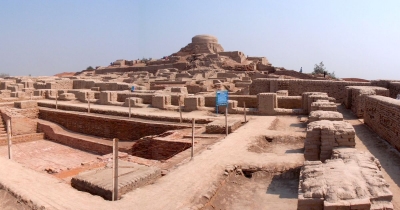
The ancient city
Situated in the modern-day Larkana district of Sindh province in Pakistan, Mohenjo Daro was ince a thriving city of the Indus Valley Civilisation. Built around 2,500 BC Mohenjo Daro meaning mound of the dead, is considered one of the world’s earliest well-planned cities. It was abandoned in the 19th Century BC with the decline of the Indus Valley Civilisation. It was rediscovered in the 1920s by an officer at the Archaeological Survey of India.
Following its discovery, several excavations have been carried out at the site, with only-third of the city’s area of 240 hectares excavated so far. The excavations have revealed evidence of art, religion, customs and administrative abilities of the Indus Valley Civilisation, along with the city’s excellent drainage system.
The site was added to the World Heritage Site list in 1980 by UNESCO for being the most ancient and best-preserved urban ruin in the Indus Valley and bearing testimony to the Indus civilization.
Architecture and layout
The city of Mohenjo Daro had been carefully planned. Spread across 240 acres, it is believed that the city once housed nearly 40,000 people. Its layout has rectilinear buildings on a grid plan and an elaborate drainage system. Most of the buildings in Mohenjo Daro were build of fired and mortared brick, with some incorporating sun-dried mud-brick and wooden superstructures.
The site consists of several mounds, which archaeologists believe grew organically over the centuries as platforms and walls were constantly built for the houses. The Great Bath, water light pool, and one of the major constructions in Mohenjo Daro, sites on the tallest mound in the city. Many believe that the Great Bath is the closest structure that Mohenjo Daro has to a temple. Next to the Great bath is the Great Hall or Great Granary, with wall divisions and air ducts.
The city had a central marketplace with a large central well. Most of the houses contained a bathing area with a drainage system. They also had inner courtyards and some were two-storeyed.
Picture Credit : Google

